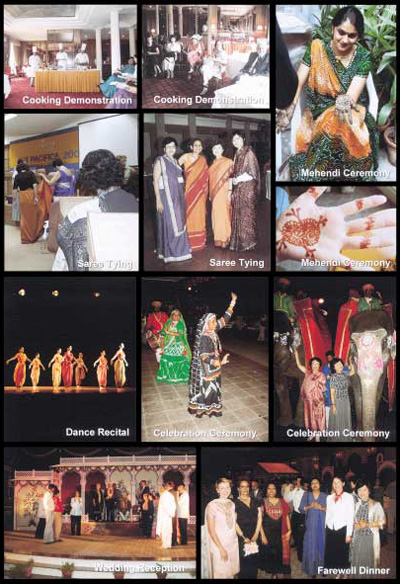The Lux Pacifica Lighting Conference Report
4. Report on Program for Accompanying Persons
It is very common for participants in international conferences to bring a spouse or other guest. At the 4th Lux Pacifica Lighting Conference (Lux Pacifica 2002 – New Delhi), a fascinating program was prepared for these accompanying persons. Table 4 shows an outline of this program.
Table 4: Outline of Program for Accompanying Persons| Monday,9th September | Tuesday,10th September | Wednesday,11th September |
|---|---|---|
09:00 at Vigyan Bhawan |
09:30 at Vigyan Bhawan |
Morning Free
|
11:30 at Meridien Hotel |
11:00 at Crafts Museum |
11:00 at Defence Colony |
12:30 at Meridien Hotel |
12:30 at Vigyan Bhawan |
12:30 at Defence Colony |
14:30 at Cottage Industries |
14:00 at Vigyan Bhawan |
Afternoon
|
Evening
|
19:00 at Kamani Auditorium |
20:00 at Ashok Hotel |
The segments of this program that were most popular among accompanying persons from each country were the “Indian Cooking Demonstration” by the chefs of the Meridian Hotel, which was planned for lunch on the opening day of the Conference (Sept. 9), the “Sari Tying Demonstration” planned for the afternoon of the second day (Sept. 10), and the “Mehendi Ceremony” planned for the morning of the final day.
Chairman Julian joined in the Cooking Demonstration with his wife. I heard that he seemed as delighted as a young boy because he had the happy occasion to celebrate his own birthday during this event, sharing his birthday cake with the ladies participating in the program.
Naturally, the men were not allowed to join in the Sari Tying Demonstration, which was held in the one of the smaller halls at the Vigyan Bhavan Convention Center. Two of the Japanese ladies participated in this demonstration, and they seemed extremely pleased with their performance.
“ Mehendi” is a traditional form of makeup used in India, in which yellow dies made from crushed henna leaves are used to draw symbolic designs on the hands and feet. It is said that once the symbolic designs have been drawn, they remain on the skin for one to two weeks. It seems that one very curious Japanese joined in the Mehendi demonstration, and that the designs remained quite visible for about two weeks after returning from New Delhi(ref. Fig. 6).

Fig.6: Outline of Program for Accompanying Persons
5. Conclusion
In the end, the 4th Lux Pacifica Lighting Conference was extremely successful, but participation in the Conference seemed to be in doubt until the very moment that the plane left Narita. Having participated in this 4th Conference, I realized that Lux Pacifica has already become firmly established. It was clear from the number of papers presented and the content of the presentations that in the face of last year’s international conditions Japan has achieved the position of a “Transmitter of Information” in the fields of lighting science and technology. I believe that Japan will continue to take on an even greater leadership role in the future.
I personally had the opportunity to participate in this International Lighting Conference in the year of its creation, and I have participated in many international conferences in subsequent years. As a result, I have been extremely fortunate to have received invaluable guidance and support from many more experienced individuals in this field.
It has been said that “Experience comes by doing.” It will be my great pleasure if the young researcher and engineers who read this paper choose to participate in the next Lux Pacifica Lighting Conference in 2005, and in many other international conferences in the future.
In closing, I would like to express my deep appreciation to Mr. Hari S. Mamak, Chairman of the Conference Working Committee, for his devoted efforts in ensuring the great success of this Conference.
* This report originally published in Japanese in J.IEIJ Vol.87, No.6, 2003 and slightly modified.| forward | 1 | 2 | 3 | |